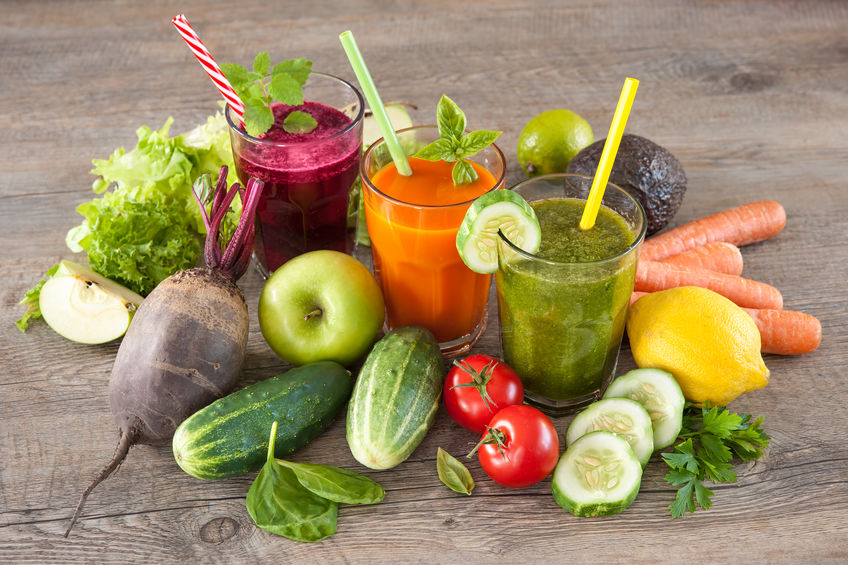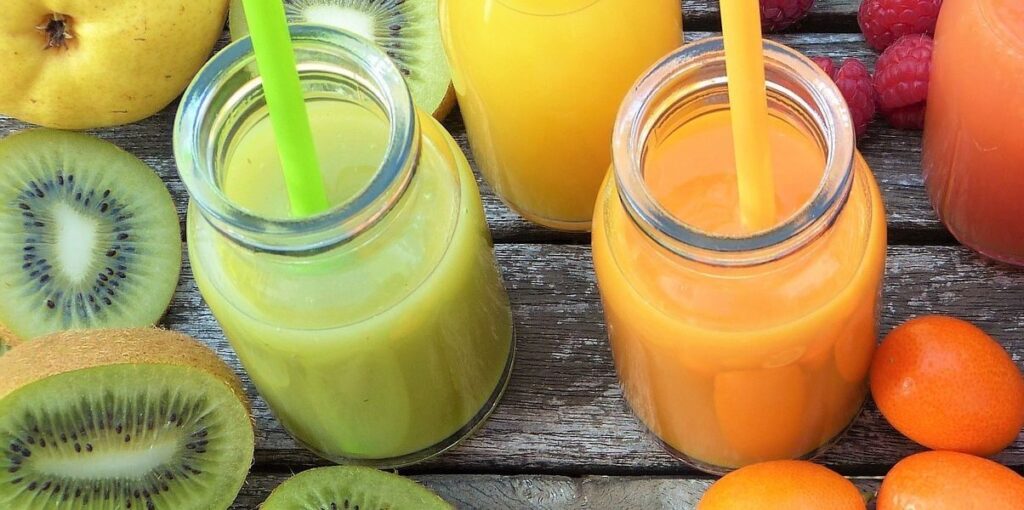Juicing is a great way to
add nutrients to your diet
Trusted Source
Juicing: Good or Bad? - Healthline
If you find it difficult to get the recommended amount of fruits and vegetables into your diet each day, juicing can be a convenient way to increase your intake.
One study found that supplementing with mixed fruit and vegetable juice over 14 weeks improved participants’ nutrient levels of beta carotene, vitamin C, vitamin E, selenium, and folate.
Furthermore, a review of 22 studies found that drinking juice made from fresh fruits and vegetables or blended powder concentrate improved folate and antioxidant levels, including beta carotene, vitamin C, and vitamin E.
www.healthline.com
. If you’re struggling to include the recommended five servings of fruits and vegetables per day, you may find that juicing offers an excellent solution.
However, once you start investigating juicing, you will quickly wonder which is best? The masticating vs centrifugal juicer debate is ongoing. There are people on both sides of the argument who will vehemently contend that their preferred option is best.
Masticating and centrifugal juicers both have their pros and cons, and different juicing techniques. So, here we’ll explore both types of juicers, the usage and the advantages and disadvantages to help you to make a more informed purchase decision.
Masticating juicers take their name from the way they chew and crush the fruits or vegetables. Essentially, the juicers chomps all the pieces, moving at a slow speed to eject fibrous materials and deliver a delicious juice.
The main advantage of masticating juicers is that because this is a slow process, the juice retains more of the nutrients. There is less heat, so the juice will not oxidize as quickly and it will have a better texture and taste.
When you start looking at masticating juicer vs centrifugal juicer models, you will see that they have a radically different design. Masticating juicers have a chute to feed through the chunks of fruit or vegetables with a plunger to push them down into the mechanism.
As the crushed food passes through the tube, it is pushed into a rotating auger to extract the juice. Depending on the type of juicer, there may be one or two augers. Two auger or twin gear juicers typically offer a higher quality juice, since it is pressed twice.
Once the fruit or veggies have passed through the augers, it travels through a filter, where the pulp is separated from the juice.
Juicing using a masticating juicer does take longer, since it works at up to 100 RPMs. This slower princess produces a dryer pulp since more juice is squeezed from the fibrous matter.
Additionally, since there is less oxidation, juice from a masticating juicer will typically have a longer shelf life. Providing it is in an airtight container in the fridge, it could last 24 hour or more without any loss of quality. So, you can juice enough for the whole day, which can be a massive time saver.
Masticating juicers can handle practically anything, but they are particularly good at juicing greens. They can extract far more juice from greens such as kale or wheatgrass, particularly if you have a dual auger machine. They can also be a good idea for juices that tend to be more vulnerable to oxidation such as apples.
As I touched on above, masticating juicers can also be a great choice if you want to prep juice for the whole day, as masticated juices have a longer shelf life.
Juice Contains More Nutrients: Masticating creates lower oxidation levels, so more nutrients in the juice are retained.
More Juice Extraction: You should also find that masticating produces a higher yield of juice from the same amount of fruit.
Juice Almost Anything: You can juice almost fruits or vegetables in a masticating juicer, you just need to make sure that the pieces are small enough to fit into the feed tube.
Better Taste: Since masticating is a slower process, it can produce a better tasting juice with a nicer texture.
More Costly Units: Masticating juicers are typically more costly compared to centrifugal juicers, which are typically more inexpensive.
Hard to Clean: With the auger units, a masticating juicer can be harder to clean. You’ll need to fully disassemble the juicer and many components are not suitable for washing in your dishwasher.
Slower Process: Juicing with a masticating juicer is a slower process compared to using a centrifugal juicer, so you’ll need to be prepared to spend more time.
On the other side of the centrifugal vs masticating juicer debate is this more economical fast spinning type of juicer. These juicers are a great option for a quick juice, but you will need to drink it immediately.
Centrifugal juicers typically spin at up to 22,000 RPMs, which allows the juice to be exposed to a lot more air and therefore oxidize faster. You may also notice that there is a foam on the top of your juice, which is caused by air bubbles.
As its name suggests, centrifugal juicers work on the same principle as a centrifuge.
There is a fast-spinning disc with lots of tiny little holes. The fruits and vegetables are dropped down from a chute above this disc, which pushes juice out of one side, while the pulp is forced out of the other.
Typically, centrifugal juicers are smaller than masticating juicers. Although you can buy vertical masticating juicers, centrifugal juicers typically have a smaller footprint. This can make them a little easier to place on your kitchen countertop and store.
As with masticating juicers, your centrifugal juicer will be supplied with a receptacle to collect the juice and pulp, just be sure that they are placed correctly before you begin, as once you start juicing, juice and pulp will be rapidly expelled from the machine.
Centrifugal juicers are a great option for juicing harder fruits or vegetables. They can also be a good choice for items with a higher water content. So, they are a solid choice for apples, carrots, cucumbers and watermelon.
However, a centrifugal juicer will struggle to handle leafy greens. You are likely to find the greens expelled into the pulp container with relatively no juice extracted.
You are also likely to find that the pulp is wetter as less juice is extracted. Some users run the pulp through the machine again or you could extract more juice by straining the pulp using a nut milk bag.
This can be a far messier process, and you may notice splatters of juice on your countertops and kitchen walls that occur due to the high spinning disc.
However, centrifugal juicers can be a little easier to clean. There are typically fewer parts for washing and many are dishwasher safe. However, the actual centrifugal disc can be difficult to clean, as it has lots of holes. You will need to use a stiff bristle plastic brush to scrub it clean after each juicing session. But, if you’re after the best easy to clean juicers, you’re likely to be looking at a centrifugal model.
Less Costly: Centrifugal juicers are typically less expensive to purchase. You can pick up an inexpensive model and it is likely to have similar functionality to the more expensive brands.
Easier to clean: With fewer parts, centrifugal juicers are typically easier to clean compared to the more complicated masticating juicer.
Faster Juicing: Centrifugal juicers operate far more quickly than a masticating juicer, so if you want your juice in a hurry, you’ll enjoy using a centrifugal juicer.
Works Well With Hard Produce: Centrifugal juicers work very well with harder fruits and vegetables such as carrots and celery.
More Oxidation: Since the juicer operates at far higher speeds, the juice will be more oxidized. This will mean that your juice will go bad more quickly. So, you will need to drink your juice almost immediately.
Less Extraction: Centrifugal juicers also extract less juice compared to a masticating model.
Won’t Handle Leafy Greens: Some vegetables such as leafy greens will not properly go through a centrifugal juicer and may simply be ejected into the pulp bin with minimal juice extraction.
If you’re still wondering the best choice in the masticating vs centrifugal juicer debate, you’ll need to think about your preferences and requirements.
If you plan on juicing greens regularly, you may find a centrifugal juicer frustrating. However, if you simply want a quick juice fix, you may prefer the fast action of this type of juicer.
While masticating juicers can handle practically any fruit or vegetable, they are slower to use and there is a higher initial outlay. Centrifugal juicers are typically less expensive to purchase, but the higher operating speeds increase oxidation, so you’ll need to drink the juice almost immediately or it will lose important nutrients.
The ultimate decision of which is best will depend on you, but regardless of which type of juicer you choose, you can enjoy delicious, fresh juice every day.





